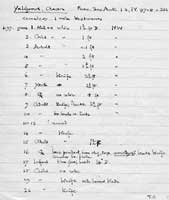| |
| |
| |
| |
| |
| |
ANGLO-SAXON OXFORDSHIRE
YELFORD ANGLO-SAXON CEMETERY
Stephen Stone recorded that Anglo-Saxon artefacts were found by gravel diggers in 1857 and 1858 from a site between the villages of Hardwick and Yelford. An Anglo-Saxon cemetery was revealed in February 1857 when six graves were uncovered. Later that same year a further thirteen graves were found on the site. The exact site of this cemetery is now unknown but it is described as a mile west of the Anglo-Saxon cemetery at Standlake.
List of graves with their finds and a map of their positions at Yelford made by ET Leeds. (Click on the image to see a larger version) |
|
The Yelford cemetery contained a mixture of adult and child burials. Most graves did not contain any grave goods, and of those that did the majority only contained a knife. In fact, only one grave had a large number of objects, that of a woman, known as grave 16. This grave contained a key, knife, amethyst bead, fragments of a chain, a bone disc and a few other iron and bone fragments. However even this grave was not overly wealthy compared to other Anglo-Saxon burials in Oxfordshire, and elsewhere.
 |
 |
Finds from the Settlement site - bone pin and spindle whorl (AN1966.204-205) |
|
Stone also recorded the discovery of an Anglo-Saxon settlement slightly further to the north-west than the cemetery. Cropmarks visible on ariel photographs taken by G.W.G. Allen in June 1936 appear to show evidence of this settlement.
In January 1858, the bottom of a sunken-featured building was found by gravel diggers. Fragments of pottery, bone objects, animal bones, burnt stones and ashes were found, but only a few objects have survived and are now held by the Ashmolean Museum.
At the cemetery site, four pits containing fragments of pottery and animal bones were also discovered, but their use was uncertain, although the objects found were probably contemporary with the cemetery.
 |
 |
All the objects from Stone's discoveres are now in the Ashmolean Museum. Most were acquired as a result of Stone's bequest to the museum in 1865. However a few others were not acquired until 1971, but have been identified on the basis of Stone's labels which were still attached.
See some of the finds from Yelford
|
|||
REFERENCES:
S. Stone (1859) "Account of certain (supposed) British and Saxon remains, recently discovered at Standlake, in the county of Oxford", Proceedings of the Society of Antiquaries of London, 4, pp 92-100.
S. Stone (1859) "Letter to J.Y. Akerman concerning excavations at Standlake, Yelford and Stanton Harcourt", Proceedings of the Society of Antiquaries of London, 4, pp 213-219.
Amethyst bead from grave 16 is illustrated in Archaeologia XXXVII, 97, pl. III items 10 & 11.

